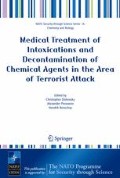Abstract
Medical research is a branch of biological research, as a fundamental area of scientific research. The results of medical research could be pharmaceutical products, diagnosis methods, surgical or investigational techniques, that are used for medical protection in an NBC environment. The main fields covered by biomedical research in NBC protection are: toxicology, radiobiology, microbiology, pharmacology, pharmaceutical techniques, internal medicine etc. New drugs and vaccines, diagnosis, treatment and prophylaxis methods are the final results of these activities. Rarely, depending on the level of technological development, there is research in the field equipment for pathogens or noxious chemicals identification. The steps required to obtain a new pharmaceutical products are many and often very difficult to go through. The first step is biochemical synthesis of the experimental product, followed by preclinical experiments. These include “in vitro” tests and experiments on laboratory animals that could be forbidden by law, especially if they kill the animal. A very sensitive step is clinical experiment. This supposes to follow all legal aspects regarding experiments on human beings. Also teratogenic, oncogenic, citotoxic effects must be identified, in order to avoid harmful effects on the treated persons. The minimum time to introduce a new drug or vaccine in the medical practice is about ten years. In the biomedical research for NBC pharmaceutical products a very important issue is to find the producer and the funds for them. Due to such difficulties these products are named “orphan products”. This very important aspects requires the involvement of government and public authorities, because the lack of “orphan products” is followed by losses of human lives.
Access this chapter
Tax calculation will be finalised at checkout
Purchases are for personal use only
Preview
Unable to display preview. Download preview PDF.
REFERENCES
Burda AM, Sigg T. Pharmacy preparedness for incidents involving weapons of mass destruction. Am J Health Syst Pharm 2001, Dec, 1, 58(23): 2274–84;
Food and Drug Administration, USA. Improving Public Health through Human Drugs. Report 2001. http:/www.fda.gov/cder/cder.org.htm;
Lang J, Wood SC; Development of Orphan Vaccines. An Industry Perspective. Emerging Infectious Diseases, 1999, 5(6): 749–755.
Matherlee K. The Public Stake in Biomedical Research: a Policy Perspective. National Health Policy Forum, November 1999, USA. http:/www.cdc.gov/nih;
Mircioiu C., Voicu V. Self protection of pharmaceutical companies against terrorist attacks as core of large area population protection. Proceedings of CB Medical Treatment Symposium Industry I, 151–153, 1998, Dubrovnik, Croatia;
Schwartz B., Rabinovich NR; Stimulating the Development of Orphan (and Other) Vaccines. Emerging Infectious Diseases, 1999, 5(6):832;
Shah ND; Vermeulen LC; Santell JP and all. Projecting future drug expenditures. Am J Health Syst Pharm, 2002, 59(2):131–140;
Voicu V., Mircioiu C. Antidotes – Individual protection means: drugs and special means. Proceedings of CB Medical Treatment Symposium Industry I, 315–326, 1998, Dubrovnik, Croatia;
Watson R. Health ministers to help orphan drugs. British Medical Journal, 1995; 310:1557–1558;
Wong SH; Challenges of toxicology for the millennium. Ther Drug Monit, 2000, 22(1):52–57.
Author information
Authors and Affiliations
Editor information
Editors and Affiliations
Rights and permissions
Copyright information
© 2006 Springer
About this paper
Cite this paper
Paul, F. (2006). PARTICULARITIES IN RESEARCH, PRODUCTION AND ACQUISITION OF THE PHARMACEUTICAL PRODUCTS FOR NBC MEDICAL PROTECTION. In: Dishovsky, C., Pivovarov, A., Benschop, H. (eds) Medical Treatment of Intoxications and Decontamination of Chemical Agent in the Area of Terrorist Attack. NATO Security Through Science Series, vol 1. Springer, Dordrecht. https://doi.org/10.1007/1-4020-4170-5_15
Download citation
DOI: https://doi.org/10.1007/1-4020-4170-5_15
Publisher Name: Springer, Dordrecht
Print ISBN: 978-1-4020-4168-6
Online ISBN: 978-1-4020-4170-9
eBook Packages: Biomedical and Life SciencesBiomedical and Life Sciences (R0)

